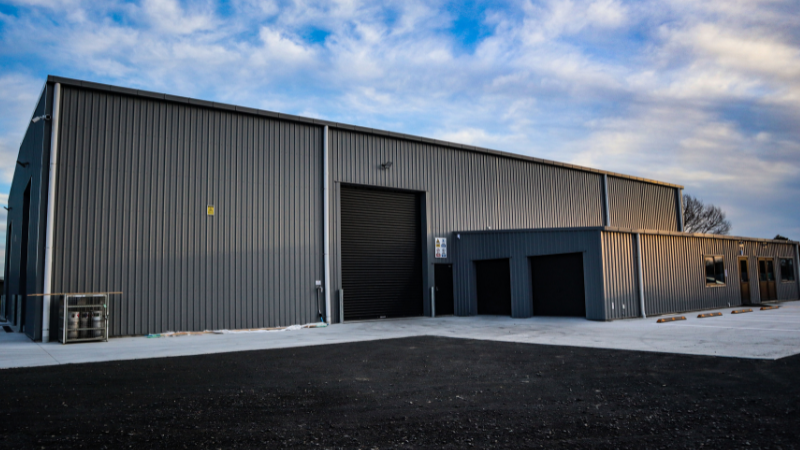Commercial warehouse building design considerations for cold regions

When designing a large warehouse in a colder region, there are certain building design considerations you need to make. By understanding the impact of snow and extreme temperatures, you can ensure your new building is reliable, energy-efficient, and built to last.
In this article, we explore the key design considerations for a large-scale warehouse in a colder region. If you are planning a project in the colder climate zones of New Zealand, find our advice and tips below.
Warehouse design advice for cold regions
When building a warehouse in a cold climate, it pays to take the time and consider the following factors:- Snow loading requirements
- Warehouse insulation and heating
- Sheltered loading bays
- Energy efficiency
- Segmentation
SNOW LOADING REQUIREMENTS
Heavy snowfalls can impact the structural integrity of buildings. To ensure buildings can hold the weight of estimated snow loads, the Building Code has a minimum ground snow load in the Verification Methods for Structure (B1).
New Zealand is divided into six snow zones, determining the maximum snow loadings for each altitude. The North Island consists of the two warmer zones where limits are higher. The South Island is divided into four zones – N2, N3, N4, and N5. The two zones that have the higher snow loading are N4 and N5, N4 is Canterbury, and parts of Otago. N5 is Southland up into Central Otago. The snow loading is calculated by taking the height above sea level of your site and seeing what KPA load that translates to in each zone. Areas of higher snow zone include inland Mid Canterbury (such as Methven), elevated areas in the Mackenzie country (Tekapo/Twizel), and Central Otago (Cromwell).
A higher snow zone area will have a significant impact on the design of the building. Purlins, rafters, and bracing need to be strengthened to take the additional loads.
We have had years of experience building in high snow zone areas and engineering our clients’ buildings to suit their specific site and location.
Our team would be happy to discuss your specific site and how your site requirements will impact the project costs.
Get in touch with our team at XL Structural to discuss what the design options are for your high snow zone site.
Warehouse Insulation and heating
While an industrial warehouse/workshop does not usually need to be insulated to meet compliance, many do consider investing in effective insulation for staff productivity and retention. This will allow you to heat the warehouse during the colder months in an energy-efficient manner.
The best insulation for warehouses varies depending on the rest of the building's design. However, common options are:
- Pink batts in the building cavity, lined with plywood, MDF, or GIB.
- Roof blanket as a roof underlay.
- PIR/EPS panel - often known as a freezer panel or cool store panel.
- Roof Logic insulation between layers of roof cladding.
- Heated flooring - there are several options when it comes to the best solution for your workshop.
Examples of projects that have insulated workshops are Dyno and Telfers Electrical.
What are the benefits of heating your workshop?
- Staff retention - it’s often cited particularly in the South as a reason people enjoy working through the winter if there’s a warm workshop environment. With anecdotal evidence of fewer sick days.
- There is also a productivity factor. It’s often seen around industrial and commercial buildings and workshops people congregate around the heaters, creating more downtime.
- In some manufacturing processes and settings it’s an advantage to the production output.
- Some elect to just heat a part of the exposed concrete floors for example if you’ve got a showroom or offices with 300-400 m2, you want a consistent heat through those areas rather than just warming up the air inside.
SHELTERED LOADING BAYS
A sheltered loading bay or canopy provides a dry, protected space to move vehicles or stock in and out of your warehouse. Aim to design any loading bays or warehouse doors on the leeward side of the building. In climates prone to rain, sleet, hail, or snow, this will help to keep your team warm and dry and reduce damage to stock.
In addition to protecting the external loading zone, the shelter will also protect the internal space of your warehouse when the doors are open. If your operations require the door to be open for extended periods, it may also be worth considering a transitional area or strip wall partition between the warehouse and the loading zone. Read more about the different types of canopies here Canopies explained: The types, pros, and cons.
ENERGY EFFICIENCY
To avoid heating more space than you require, it is important to spec the building to the correct height requirements. This can reduce your energy consumption significantly and keep your employees at a comfortable temperature. The correct height, depends on what you require to make your operation functional.
Installing solar can also reduce your heating costs, which is especially important during winter. However, note that this may require a robust power storage system for days with less available solar energy. For advice on how to design energy-efficient buildings, ask our experts at XL Structural.
SEGMENTATION
For many warehouses, there are various functions and operations taking place in different areas. To ensure each area is easy to heat as required, it is sometimes worth separating them with an insulating curtain, partition, or wall.
For example, a thermal curtain can section off a packing area or small assembly area where staff are working so this area can be heated efficiently without wasting energy heating the whole warehouse. This will reduce your heating costs, ensuring the essential space is heated first. Some elect to just heat a part of the exposed concrete floors for example if you’ve got a showroom or offices with 300-400 m2, you want consistent heat through those areas rather than just warming up the air inside.
If you are wondering how to design an office building, consider building a segmented area, room, or a mezzanine floor that can be insulated as a separate room. This way, office staff can work effectively in a warm, quiet environment while warehouse staff work in the main warehouse area.
INDUSTRIAL WAREHOUSE NZ
If you’re planning to build a new warehouse, the team at XL Structural is here to help.
When you’re ready to look at a new build to scale up your business operation, our team can work closely with you to optimise your next commercial warehouse. From 3PL distribution hubs, to logistics operations, through to centralised warehouse storage, we have the experience and expertise to design an efficient building specific to your site and climate.
Read these articles written by our in-house experts for more information:
- 6 considerations when selecting the best height for a commercial building
- What are the options for Stormwater Management?
- What are the changes to NZBC H1 Energy Efficiency?


